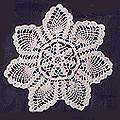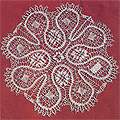Lace work is mainly found in the southern parts of the country. This craft was first introduced by the Portuguese in the middle of the sixteenth century and then developed by the Dutch in the middle of the seventeenth century. This craft is practised mainly by women, especially in the areas of Galle, Weligama, Dikwella, Matara, and Hambantota. This thriving craft provides a steady source of employment for young and old. The craft is appreciated and patronised by the locals and by foreign tourists.
Along with the introduction of this craft in the southern parts of the country, Western styles of dress and fashion have also become popular. These include the popular kabakurutthu – the Portuguese name for a ladies jacket having lace-work as decoration – which has narrow cuffed sleeves and neckline trimmed with delicate lace, fastened in the front with brooches and buttons. Lace-work is most commonly used to embellish the borders, necklines, and sleeves of ladies’ garments.
CRAFT TECHNIQUES & TOOLS
The commonly made lace is the pillow lace or bobbin lace as it is known in some countries. It is an open-work fabric made by intertwining many varieties of fine thread. It is made on a pillow-like structure mounted on a wooden base, raised on short pegs a few inches above the ground. One side of the pillow is about a foot high and the other side is about three inches high, and filled with coir. It is completely covered with a thick cloth nailed to the base all around.
At the centre of the taller end of the pillow is a rectangular compartment twelve inches long, nine inches broad, and nine inches deep. At the centre of this compartment is placed a cylindrical drum that is about six inches in diameter. This is fully covered with cloth wrappings and has a central axel that fits into two grooves at the centre of the two sides of the central compartment. It can be turned around as the work progresses.

At the centre of this drum is a parchment or stiff paper on which is found the perforated outline of the design to be knitted. This paper containing the pattern is known as isbeesalaya; it is wrapped right round the centre of the drum. At the start of the lace-weaving process, the required number of threads are hung in pairs from pins at the top of the drum with bobbins attached to the loose end. These pins are placed in accordance with the pattern on the isbeesalaya. The actual knitting is done by manipulating the bobbins to make the threads cross each other in several ways – such as the twist of two threads, a braid or a plait of four threads, and other complicated combinations. Pins are used to hold the elements of the pattern in place as the work proceeds, while at the same time the drum is turned manually.
The pins in the section where the pattern has been completed are brought forward one by one so that only a limited number of pins are made use of. The tools and equipment needed for this craft include a pillow mounted on a wooden frame, with bobbins or beeralu to carry the thread, the isbeesalaya, and pins. The word ‘beeralu‘ is of Portuguese origin; it is the name given to the wooden bobbin around which the thread is wrapped for making lace on the pillow to which the design is pinned. The term ‘renda‘ – from the Portuguese word ‘reinda‘ – refers to the pattern or ‘pillow lace’ made on a pillow.
In recent times a new style of making Belgian lace has been introduced in Maligawatta at Colombo and Dikwella in Matara district, where women are obtaining expertise in this type of lace-making at several centres. This new variety of lace-making offers a challenge to the old as a competitive new technique.

TYPES OF LACES
1. Pillow Lace
This is known thus because a stuffed pillow is used as a stand on to which a small stuffed wooden roll is fixed in the middle. The weaving is done by inter-crossing the threads, allowing the design to take shape on the roll.
2. Needlepoint Lace
Needlepoint lace is made on a frame with single and double threads so as to form knots similar to the pattern of rattening of chairs. Teapoy covers, and bedcovers are commonly made in needlepoint lace.
3. Crochet & Tatting
Crochet and tatting techniques have also been introduced and developed in Sri Lanka. They are widely practised by the women artisans in the southern areas of the country. Some of the items made include teapoy covers, bedspreads, blouses, and dresses.

CRAFT LOCATIONS
- Ampara district (on the south-eastern coast of the country): in the village of Gonagolla.
- Colombo district: in the village of Kadawata.
- Galle district (on the southern coast): in the villages of Magalle, Habaraduwa, and Kataluwa.
- Gampaha district (next to Colombo): in the villages of Kadawatta, Mirigama, and Kelaniya.
- Hambantota district (on the southern-most tip of the island-country): in the villages of Ambala, Mirijjawila, Seenimodera, Weeraketiya, Mawella, and Tangalle.
- Kalutara district (on the southwestern coast): in Kalutara town.
- Kurunegala district (near Colombo): in the villages of Udiyawela and Thorayaya.
- Matara district (next to Hambantota district): in the villages of Kudawella, Totamune, Kottegoda, Peekwella, Deeyagaha, Weligama, Issadeen Town, Polwatumodera, Wellawatta, and Demalapitiya.
- Nuwara Eliya district (next to Kandy district, in the central part of the country): in the villages of Pundaluoya, Ramboda, Maskeliya, Rikiligaskada, Kumbaloluwa, Ginigathena, Nuwara Eliya town, and Hatton-Dikoya.
- Ratnapura district: in the village of Pelmadulla.
- Trincomalee district (on the eastern coast): Trincomalee town.
INTERVENTIONS
The Department of Small industries and the National Crafts Council of Sri Lanka have continuously provided institutional support to this craft by opening up more training centres to improve quality. The National Crafts Council runs training centres in Galle, Matara, Weligama, and Hambantota where there are about 300 families keeping the craft alive. The high foreign demand for the craft products helps sustain the craft. New designs and patterns are constantly being introduced. Some of the popular items are table-mats, tray covers, and very large table cloths made on pillow lace units.
Gallery
YOUR VIEWS
PRACTITIONERS: INDIA
Access 70,000+ practitioners in 2500+ crafts across India.
BIBLIOGRAPHY
10,000+ listings on arts, crafts, design, heritage, culture etc.
GLOSSARY
Rich and often unfamiliar vocabulary of crafts and textiles.
SHOP at India InCH
Needs to be written.





